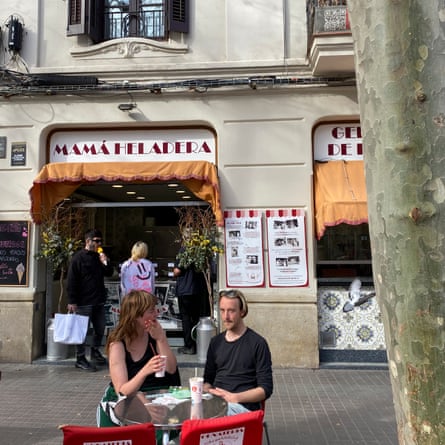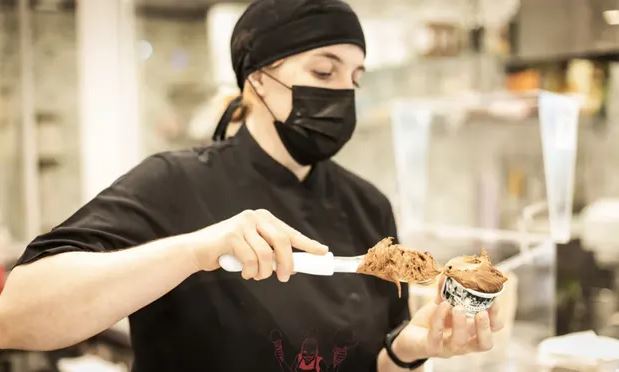Mamá Heladera’s ice cream parlour in Barcelona, Spain. Photograph: Mamá Heladera
Inspired by neurogastronomy, Irene Iborra’s menu explores the unusual flavours that evoke childhood memories
Irene Iborra tells tales with ice-cream and with a single lick she can summon up memories that send you spinning back to your childhood days.
“When I opened Mamá Heladera in 2021 I thought: how can taste provoke memories and how can I find what these tastes are?” she said.
“The obvious thing was to ask, so I created a Google doc and asked around 100 local people for the tastes and smells that reminded them of their childhood.”
At the Guardian’s request, she agreed to attempt to evoke the aromas of maple syrup, snow and pine needles that accompany the early spring Québécois ritual of sugaring off, when children are taken to the maple woods and given a small metal tray packed with snow to collect the season’s first crop of syrup. As it hits the snow it solidifies to form a sort of maple toffee.
The sorbet she produced captured it perfectly. On the palate, the first taste was pine, Canada’s definitive aroma, then just a hint of maple syrup, finishing with the unmistakable if unnameable taste of snow. For a moment, Barcelona became the wooded outskirts of Montreal.

‘When I opened Mamá Heladera in 2021 I thought: how can taste provoke memories and how can I find what these tastes are?’ said Iborra. Photograph: Stephen Burgen
It was when Iborra, the fifth generation in a family of ice-cream makers, was backpacking in Asia that she became aware of how closely our idea of where we come from is associated with the tastes and smells of childhood.
She then became fascinated by neurogastronomy when she was studying at the prestigious Escuela de Hostelería Hofmann in Barcelona, which is also where she met her business partner, Irene Vidal.
Lavender came up often in her survey as it was once common practice to hang bags of it in wardrobes, so she made a lavender and acidic cherry ice-cream.
“A lot of people mentioned croquettes, cannelloni [a traditional Boxing Day dish in Catalonia] and bechamel,” she said. “The bechamel ice-cream we make with nutmeg, black pepper, salt and vanilla.”
Her coconut ice-cream is based on people’s memories of Chang Feng, the first Chinese restaurant to open in Iborra’s own neighbourhood of Poblenou, once the heart of Barcelona’s textile industry.

For many people the smell of plasticine is intimately associated with childhood and Iborra has devised an ice-cream made with coconut and bitter almonds that recaptures the scent but fortunately not the taste.
“There are limits, you can’t make ice-cream out of just anything,” she said. “Someone wanted an ice-cream that tasted of fuet [dry-cured pork sausage] but that doesn’t work.
“One of the strangest ones we’ve made was tomato and onion, like a sofrito. It wasn’t bad, because the onion has a sweetness, but it wasn’t something we could sell.”
She’s still struggling to perfect a request for an ice-cream that tastes of sausages cooking on the barbecue. It’s called Love in March and has a smoky flavour.
Mamá Heladera is next door to El Tío Che, reputed to make the city’s best horchata – a cold drink made from tiger nuts – and run by her family since 1912.
Iborra’s great-great-grandfather left Alicante for Barcelona with the intention of taking a ship to America, but the horchata he brought with him from home caught on and he stayed.
The cafe got its name – meaning “the Che Guy” – because when it first opened he used to shout to passersby: “Pruébalo che!” (Hey, give it a go!).
In Spain, both horchata and saying che (hey) are peculiar to Valencia and Alicante.
Iborra never intended to join the family business but little by little it drew her in. “There have been some crazy ideas, learning experiences, anxiety, failures, successes, but it’s based on simple logic: what’s the smell of your childhood and what comprises this aroma?” she said. “An ice-cream can take you straight back to this memory.”
Source: Tasting memories: the Spanish ice-creams serving a scoop of nostalgia | Spain | The Guardian













